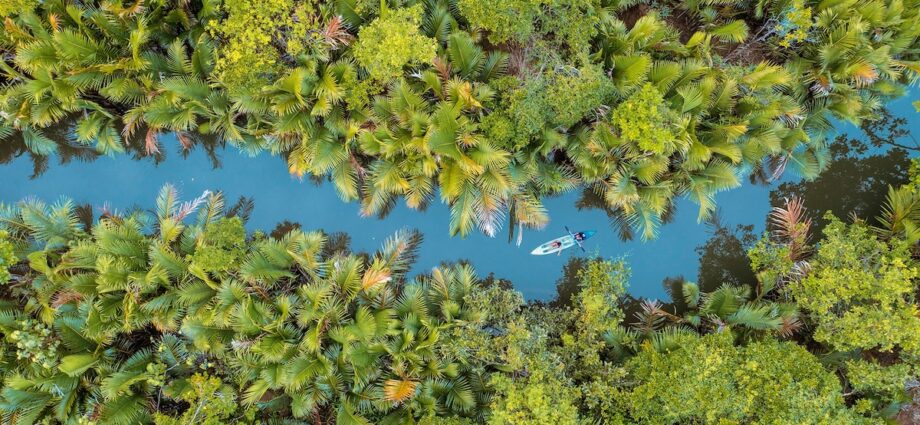This article was produced by National Geographic Traveller (UK).
Can you explain the concept of a river as a living being?
At the heart of the book is the idea that rivers have lives, deaths –– and even rights. It asks readers to imagine rivers in these terms, and to see what consequences flow from that re-imagining. The book is a journey into the history, futures, places and possibilities of this ancient, urgent idea.
I know that the notion of a river as ‘alive’ is a searching, confronting one, especially to those of us raised in the traditions of rationalism. It strikes at the anthropocentric core of many of our assumptions. But if you find it hard to imagine a river as alive, try imagining a dead or dying river. We know what this looks like, what it feels like: fish floating belly-up, channels choked with sewage and garbage, a river disappearing in its own dry bed. Unfortunately, many rivers in the world are dying. In England and Wales, in fact, right now we haven’t got a single river in ‘good overall ecological health’. This is a failure of imagination as well as legislation.
To think of a river as alive is to begin to open new ways of relating to rivers; new ways to imagine freshwater otherwise. And God knows we need such new thinking: our rivers have become first undrinkable, then unswimmable, then untouchable. How did it come to this –– and where do we go from here?
What are the three rivers you visited for this book and why?
I wanted to give the book the form of water –– of the water cycle, in fact. So, it begins and ends at the little chalk stream spring near my house, and in between it moves from the mountains to the sea, flowing downhill and gathering force, as a river does, before returning to its source. Over its course, the language itself becomes more and more liquid, as the book –– and I –– become ‘rivered’.
I made three substantial journeys/fieldwork trips in the course of writing the book (which has taken five years from beginning to publication). The first was to an Ecuadorian cloud forest named Los Cedros, the ‘Forest of the Cedars’, home to the headwaters of the Río Los Cedros, the ‘River of the Cedars’. The second was to the wounded creeks, lagoons and estuaries of the watery city of Chennai in southeast India. And the third was to the wild interior of Nitassinan, the homeland of the Innu people (also known as Quebec), through which runs the Mutehekau Shipu (also known as the Magpie River), which I followed south for 100 miles from deep in the boreal forest to make sea-fall at the Gulf of St Lawrence, several hundred miles northeast of Montreal.
Each of these rivers has become a focus for revolutionary thinking about what the philosopher Michel Serres called ‘the natural contract’. Each is a place where rivers are understood in some fundamental way to be alive –– and in each place, too, the survival of rivers is under severe threat: in Ecuador from mining, in India from pollution and in Nitassinan from dams.

Is a River Alive? is now published. Penguin, £25

“Rivers are our oldest singers, our oldest storytellers”, says Robert Macfarlane.
Photograph by William Waterworth
Did a particular river inspire the idea for the book?
Yes –– a tiny, fragile chalk stream, which rises as a clear-watered spring just a mile from my house, in a little spinney called Nine Wells Wood. I visit it several times a week and have done for more than 15 years: it’s a place where a river is born. Spring sites are, I think, the most purely magical of landscape places: self-renewing miracles. This chalk stream is my timekeeper, my memory-keeper. But it’s also desperately fragile: it’s currently on life support (in the form of an augmentation pump) to keep it flowing, and it simply may not survive past 2050 if the current trajectories of climate change, pollution and abstraction continue uncheked.
If rivers are alive, what might they be saying?
Rivers are our oldest singers, our oldest storytellers. But we’ll never ‘speak river’, because their language is incommensurable with ours. Rivers are, though, hugely powerful presences with which we can think and with which we can speak and tell stories. Early in Is A River Alive?, I openly name the rivers as my co-authors: I simply couldn’t have written the book without them. I did much of my thinking of the book either on or by rivers, which could never have been done in a library or at home. Rivers shaped countless aspects of the book, from the geography of its overall shape (from spring to mountain summit to river mouth at the sea and back to the springs), which was based on the water cycle. This question reminds me of a beautiful story by an Indian river-rights activist called Shrishtee Bajpai, about a young Ladakhi girl living on the banks of the Indus who, when asked what rights her river has, said: “The river has a right to sing!” It was at once a lyrical and an ecological observation: when the river is in good flow, it burbles over –– it sings. If it’s low and dry and sluggish, it’s silenced. We need our rivers to sing!
Published in the May 2025 issue of National Geographic Traveller (UK)
To subscribe to National Geographic Traveller (UK) magazine click here. (Available in select countries only).

